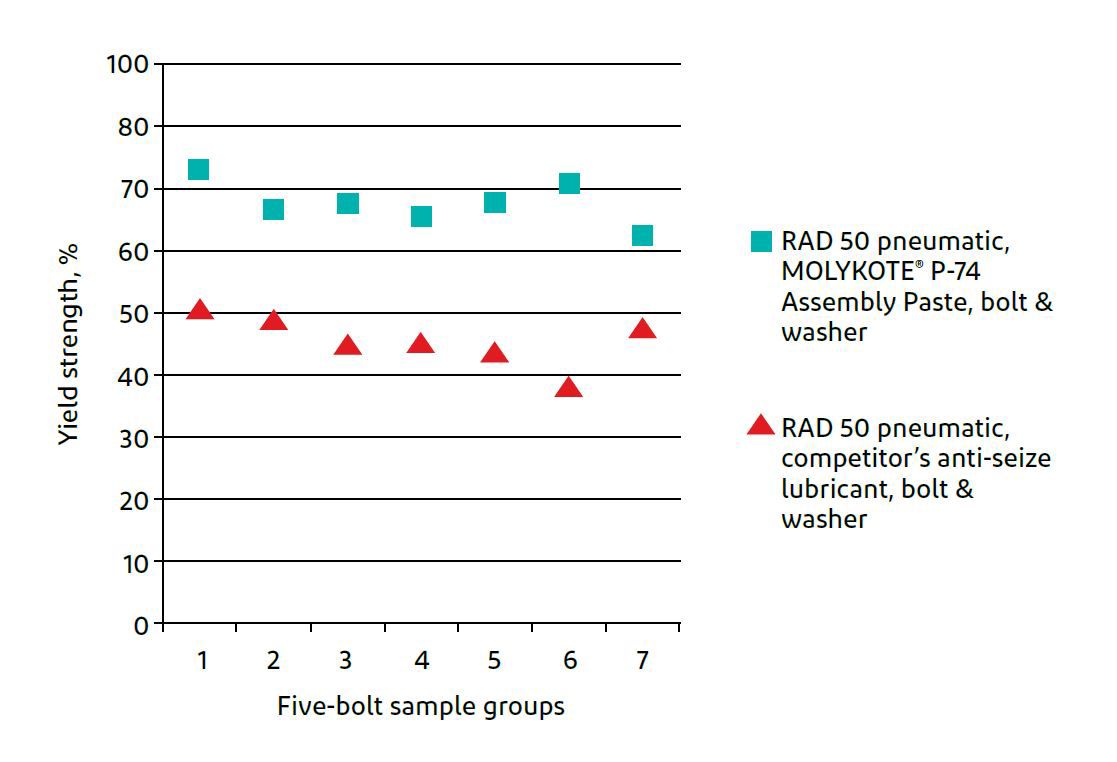Increase in Productivity in SAG Mills
Semiautogenous mills, more conventionally known as SAG mills, are big machinery that mill through mined ore, which are broken down into fine particles from large boulders and rocks. SAG mills utilize milling balls so the ore can be ground down into fine particles, a process known as comminution. The ore turn and tumble in the mill, creating an environment of high heat and constant vibrations. Downtime and repairs for SAG mills can be costly and dangerous; therefore, finding preventative measures is critical.
The Customer
Relining Minerals, a prominent distributor of industrial bolts found in mining equipment, was looking for a lubricant to protect their liner bolts found in SAG mills from high temperatures and constant vibrations during the mining process. With the assistance of Australia-based company Mining Products and Services (MPS), Relining Minerals began looking into lubricants to determine what kind would protect the bolts from elongating over the minimum stress yield threshold, causing the bolt to deform and fail.
The two companies controlled three variables within the tests they ran: the type of lubricant used, the lubricant application method, and the correct operation of the torque tools. Relining Minerals is not only a distributor of industrial bolts; they also provide lubricants and technical support. They wanted a solution that they and their customers could consistently rely on—not just as a product they could recommend but as its own preferred solution.
Problem the Customer Faced
With large-scale ore-processing plants, there are large industrial demands. To meet those demands, finding a lubricant that would reduce the frequency of plant downtime due to bolt failures and control maintenance costs was highly sought after. The optimal lubricant would protect the bolts from dusty and abrasive byproducts from the comminution process.
Mill liner bolts (shown right) secure the protective liner to the inside of the mill. Proper lubrication is essential for converting the applied torque to elongation and claping force, minimizing the risk of tension loss and fatigue failure.
Testing Different Lubricants
To meet high expectations, Relining Minerals and MPS researched many different lubricants; MOLYKOTE® P-74 Assembly Paste was one such lubricant. MOLYKOTE® P-74 Assembly Paste was primarily chosen for its low coefficient of friction. It was compared to other leading lubricant solutions.
During bolt-tensioning trials, MPS brought in a pulp lifter liner configured with M48 liner bolts from a 36-foot SAG mill. The test jig was used to calibrate the actual torque/bolt load and, through proper lubrication, get it closer to the calculated torque/bolt loads to reduce the variation in the bolt loads achieved.
In each testing scenario, MOLYKOTE® P-74 was compared to other commonly used mining lubricants, and each test showed that MOLYKOTE® P-74 Paste consistently outperformed its counterparts by at least 10%. These tests also showed that the lubricant’s application method was crucial to its performance. For example, if the liner bolts were not installed correctly and were under tensioned, the bolts would become fatigued, resulting in failure. MOLYKOTE® P-74 Paste reduces friction so a higher percentage of the applied torque can be translated into clamping force and elongation.
 As shown in the graph, MOLYKOTE® P 74 Paste and other commonly used anti-seize lubricants were compared. To compare all the different lubricants, trials were done using RAD 50 torque multiplier and best practices that were made by tensioning trials, which included the following:
As shown in the graph, MOLYKOTE® P 74 Paste and other commonly used anti-seize lubricants were compared. To compare all the different lubricants, trials were done using RAD 50 torque multiplier and best practices that were made by tensioning trials, which included the following:
- Hardened cup washer
- Lubricant being applied to the washer face and bold thread
- Utilizing the torque multiplier to stall and release the trigger, and repeating until the gun stalls again
MOLYKOTE® P-74 Assembly Paste showed increased bolt strength and reliable bolt deformation prevention under heavy stress. In seven different groups, comprised of five bolts, MOLYKOTE® P-74 Paste maintained a consistent yield strength closer to 70% compared to other leading lubricants.
Molykote® P 74 Paste: The Clear Choice
Once testing for the optimal lubricant had concluded, Relining Minerals and MPS began recommending MOLYKOTE® P-74 Paste as the preferred mill liner specialty lubricant. The tests showed that the MOLYKOTE® lubricant consistently kept the bolt operating in the optimal elongation range while minimizing tension loss. This resulted in fewer instances of bolt failure and minimized the occurrences of SAG mill downtime.
By preventing both the bolt and its liner from loosening, the number of instances of the plant’s unscheduled downtime was reduced, increasing productivity. The physical risks associated with calibrating and adjusting equipment due to bolt failure were also reduced since the main cause of physical injuries was tied to the calibration and adjustments performed during maintenance.
Reliability of Molykote® P 74 Paste
MOLYKOTE® P 74 Paste is an ideal lubricant to prevent bolt loosening and hold mill liners in place. Moreover, MOLYKOTE® P 74 Paste is a specialty lubricant that is also suitable for a wide range of industrial applications, such as:
|
Bolted connections
|
Exhaust bolts
|
|
Sliding contact bearings
|
Spark plug threads
|
|
Linear sliding guides
|
Flanges and flange seals
|
|
Splined shafts
|
Door hinges
|
|
Press-fit joints
|
Brake mechanisms
|
MOLYKOTE® P-74 Paste offers high load-carrying capacity, good corrosion protection, and a broad operating temperature range (−40°C to 200°C). This specialty lubricant also has a low coefficient of friction that helps in the following:
- Facilitating disassembly, even after extended periods and demanding or unfavorable conditions
- Avoids fastener brittleness or environmental contamination, courtesy of its metal-free formulation



